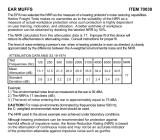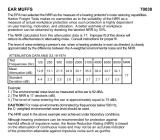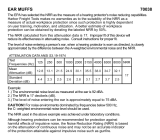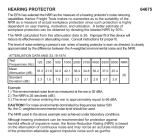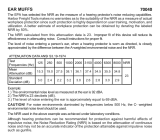
E•A•RLog® is a registered trademark of Aearo Company. Copyright 1996. First printing 1984
LIT. CODE 30305 2/99AG
A PLUG AND A MUFF
INDIVIDUALLY AND COMBINED
FREQUENCY (kHz)
10
20
30
40
50
60
0
10
20
REAL-EAR ATTENUATION (dB)
STANDARD DEVIATION (dB)
STD. DEV.
MEAN ATTN.
.125 .250 .500 1.0 2.0 3.15 4.0 6.3 8.0
par. insertion foam 17
muff #1 21
par. insertion foam + muff #1 29
estimated BC limits 35
Figure 3
NRR
formance gain at individual frequen-
cies was found to vary from approxi-
mately 0 - 15 dB over the better of the
individual HPDs, except at 2 kHz
where no combination exhibited a gain
of greater than 3 dB. The gain in the
Noise Reduction Rating (NRR) for the
double protection combinations ranged
from 7 - 17 dB when compared to the
plugs alone, 3 - 14 dB when compared
to the muffs alone, and 3 - 10 dB when
compared to the better of the two indi-
vidual devices.
An example of the performance of each
of the earplugs worn in combination
with muff #2 is shown in Figure 4. For
the lower and middle frequencies the
attenuation varied by approximately 20
dB across the different combinations
as a function of the attenuation of the
earplug. In contrast, above 2 kHz the
net performance was BC limited (c.f.
Figure 3) and was equivalent for all
combinations. When the performance
of different muffs worn over selected
earplugs was examined, it was found
that the net attenuation was essentially
independent of the particular earmuff,
suggesting that in such cases the
choice of earmuff was relatively unim-
portant
3
.
Discussion
As has been discussed in this series of
articles
2
and in the recent literature
4
, the
attenuation of HPDs in real-world envi-
ronments fails short of laboratory pre-
dictions. To assess the effects of field fit-
ting on the performance of dual HPDs,
one test was conducted with a purposely
misfitted device, a partially inserted foam
earplug.
The partial insertion test was designed
to approximate utilization that is attain-
able in the field with limited instruction
and motivation. This was validated by
measuring the laboratory attenuation of
E-A-R® foam earplugs using 92 un-
trained listeners who fitted the plugs
themselves according to the
manufacturer's instructions, but without
supervision
5
. Many of them had not pre-
viously worn HPDs. The NRR from that
study agreed within 1 dB with the value
shown in Figure 1 for the partially in-
serted foam earplug. Therefore, the Fig-
ure 3 data for the partially inserted
E-A-R® Plug combined with the E-A-R®
Muff (muff #1) may be assumed to pro-
vide an indication of what can realisti-
cally be obtained with a comfortable
combination of lightweight protectors.
No similar attempt was made to "real-
worldize" the fitting of the other plugs or
any of the muffs in this study. Therefore
all of the double HPD data will reflect an
upper bound on the values attainable
under field conditions, especially since
one must consider both the reduced
comfort of dual HPDs and the fact that
when an earmuff is worn over an ear-
plug, observation and enforcement of the
correct usage of the plug becomes more
difficult.
Conclusions
When the real-world attenuation of a
single HPD is inadequate, which is likely
to be the case if equivalent 8-hour A-
weighted exposures exceed 105 dB the
utilization of double HPDs is an alterna-
tive that should be considered. This is
especially important when the noises are
dominated by lower and middle frequen-
cies, since it is in this frequency range
that the attenuation of single HPDs will
be the lowest, making the extra protec-
tion provided by the combination most
necessary. The performance of the com-
bined devices is relatively unaffected by
the earmuff that is selected but at the
frequencies below 2 kHz is strongly in-
fluenced by the choice of earplug. At and
above 2 kHz all plug-plus-muff combi-
nations that were studied provided at-
tenuation that was limited only by the
flanking bone conduction pathways to
the inner ear.
VARIOUS EARPLUGS IN
COMBINATION WITH ONE EARMUFF
FREQUENCY (kHz)
10
20
30
40
50
60
0
10
20
REAL-EAR ATTENUATION (dB)
STANDARD DEVIATION (dB)
.125 .250 .500 1.0 2.0 3.15 4.0 6.3 8.0
muff #2 21
fiber + muff #2 25
premolded + muff #2 29
par. insertion foam + muff #2 30
std. insertion foam + muff #2 32
deep insertion foam + muff #2 35
Figure 4
NRR
STD. DEV.
MEAN ATTN.
References and Footnotes
1. Zwislocki, J. (1957). "In Search of the Bone-Con
duction Threshold in a Free Sound Field," J.
Acoust. Soc. Am. 29(7), 795-804.
2. Berger, E.H. - The EARLog series is available
upon request from Aearo Company.
3. Berger, E.H. (1983). "Laboratory Attenuation of
Earmuffs and Earplugs Both Singly and in Com
bination'" Am. Ind. Hyg. Assoc. J. 44(5), 321-329.
4. Berger, E.H. (1983). "Using the NRR to Estimate
the Real World Performance of Hearing Protec
tors," Sound and Vibration 17(1), 12-18.
5. Berger, E.H. and Kerivan, J.E. (1981). "Estimat-
ing Hearing Protector Attenuation for the Second
Percentile Using Parametric Statistics," J. Acoust.
Soc. Am. Suppl.1, 70, S107.


